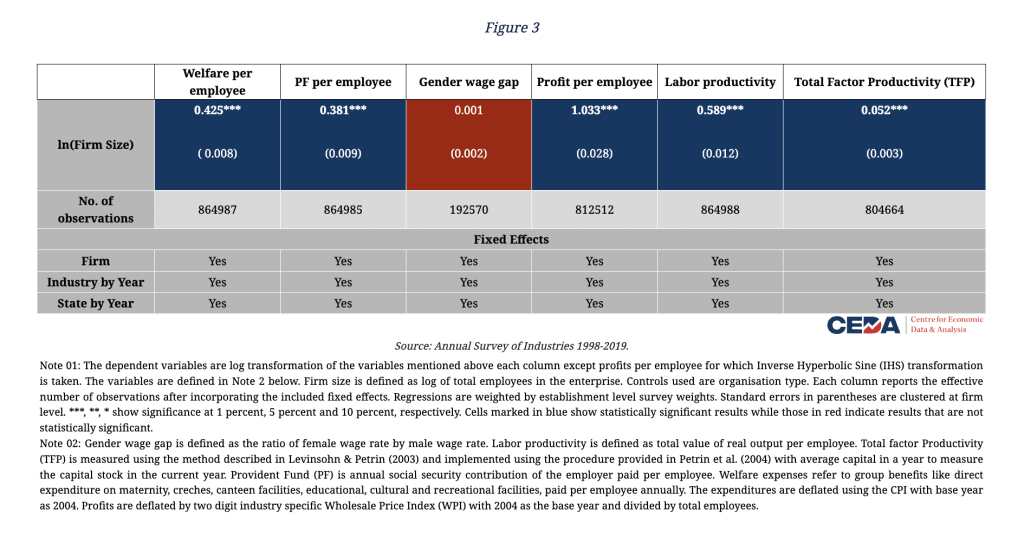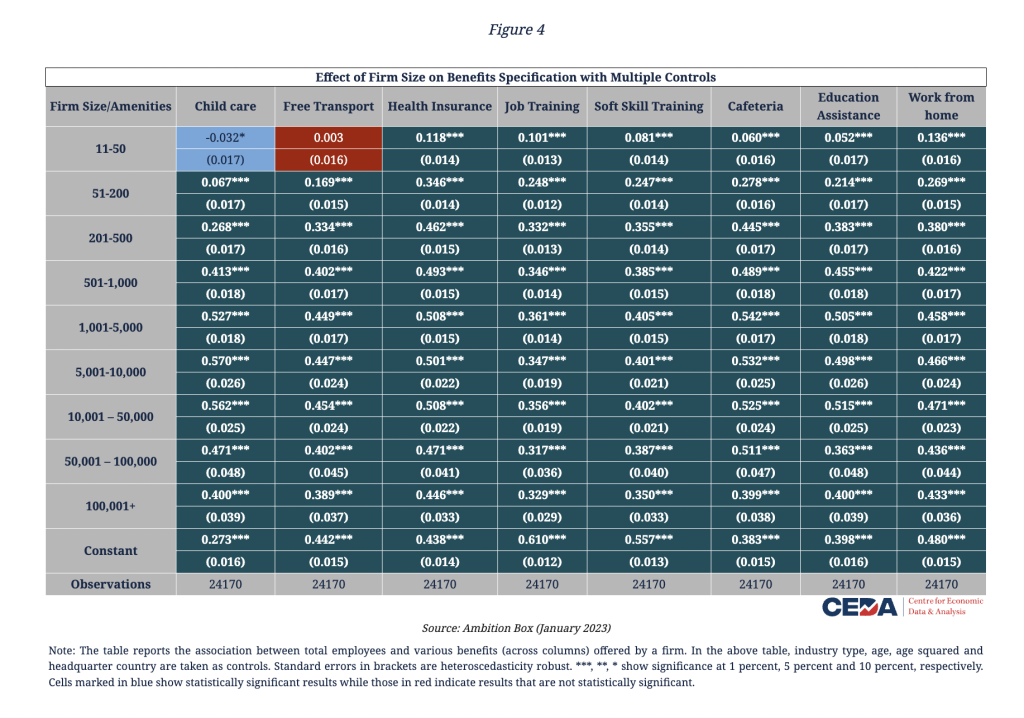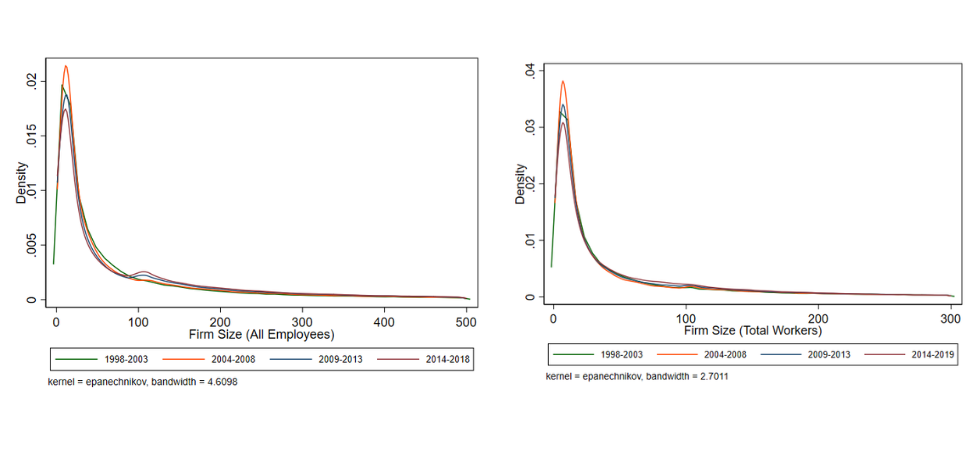Does the size of an organisation have any link to the share of women it employs?

Key Highlights
- Firms with a larger number of total employees had a higher proportion of female workers
- For every 1 percent additional workers firms hire, the share of women workers increases by 0.47 percent, an analysis of data from the Annual Survey of Industries (1998-2019) shows
- Bigger firms are more likely to offer non-wage benefits to their employees, and many of these benefits tend to be particularly valued by women
- India has some of the lowest rates of female labour force participation in the world
- Nearly 98 percent of firms in India are micro in nature, i.e., have a size of fewer than ten employees, and this firm-size distribution could be limiting female employment in the country
Less than a quarter (24 percent) of women aged 15 years and more were part of India’s labour force in 2022. This was nearly half the global average of 47 percent, and much behind some of the major economies of the world, data from The World Bank based on the International Labour Organisation’s modelled estimates shows (Figure 1).

Research tends to attribute variation in social norms and the U-shaped association of female employment with income and educational changes across countries as primary explanations behind the observed patterns of their respective female labour force participation rates (FLFPR).
However, the difference in the demand for women due to variations in attributes of firms that employ them is a factor that can also impact availability of suitable labour market opportunities for women. But this factor has received far less attention in explaining the observed disparities.
We analyse data from the Annual Survey of Industries 1998-2019 (ASI), and various rounds of the Periodic Labour Force Surveys (PLFS), National Sample Survey (NSS) and the Economic Census of 1998, 2005 and 2013 to understand whether the size of firm makes a difference. This is what we find:
Firms with a larger number of total employees had a higher proportion of female workers
Using ASI data from 1998-2019, we find a significant positive elasticity of 0.47 between the number of workers hired by a firm and the share of women workers (Figure 2). In simple words, this means that for every 1 percent additional workers firms hire, the share of women workers increases by 0.47 percent. This positive relationship also holds when firm size is measured using total output, with an elasticity of 0.1.

This positive relationship is statistically significant and robust even if we use alternative definitions of women’s employment such as share of female worker-days or presence of female workers. Further, we look at data from three rounds of Economic Census of India (1998, 2005 and 2013). The Economic Census captures unorganised and the organised sector firms across all industrial sectors – agriculture, construction, manufacturing, and services.
Here too, we find a significant positive association (elasticity of almost 0.7) between the number of hired workers and proportion of female hired workers, and this positive relationship holds across all major industrial sectors. We corroborate these findings with two other data sources: National Sample Surveys (1999-2012) and the Periodic Labour Force Surveys (2017-2019). These surveys collect data on repeated cross-sections of households and individuals, on their employment status and establishment size, based on the total number of employees. Here too, similar findings emerge. Female workers are 27 percent more likely (vis-a-vis male workers) to be employed in firms having 20 or more workers versus firms having less than 6 workers.
But why is this the case?
Non-wage benefits offered by bigger firms may play an important role
There are multiple reasons why this positive association might occur. First, bigger firms can offer higher employee benefits to both men and women, and many of these benefits tend to be valued more by female employees.
Analysis of ASI data shows that an increase in firm size by 1 percent increases the welfare benefits per employee by 0.42 percent. The per capita pension benefits also increase by 0.38 percent when the firm size increases by 1 percent (Figure 3).

Further, NSS and PLFS data show that workers employed in larger firms (20 or more workers) are 70 percent more likely to get maternity benefits, 45 percent more likely to get paid leaves, 50 percent more likely to have a written contract, and 70 percent more likely to get pension benefits from their employers as compared to workers employed in firms with less than 6 workers.
Using additional data on reported benefits by employees on an aggregator platform in India called AmbitionBox, we again find that bigger firms are more likely to provide child care, free transport, and work from home, apart from other amenities. Estimates show that a firm having 500-1000 employees is almost 40 percentage points more likely to offer these benefits vs. firms having at most 10 employees. This corresponds to almost 100 percent increase for benefits such as child care and 60 percent for free transport.

Larger firms may be better placed to invest in such benefits because they have higher revenues, profits and also because it is more cost-effective to provide such services and infrastructure for a bigger worker pool than for a handful of workers. These possibly indicate that bigger firms are able to attract more women due to these non-wage benefits.
Notably, we do not find any decrease in the ratio of female to male wages in bigger firms. This indicates that bigger firms do not compensate for the non-wage benefits by reducing the monetary wages they offer to women vis-a-vis the wages offered by smaller firms. This isn’t because firms are being conscientious but possibly because the marginal productivity of women is higher in bigger firms compared to smaller firms.
Our argument is based on a task-based explanation that leads to greater relative demand for women in bigger firms and, consequently, higher investment by them in amenities valued by women leading to ambiguous effects on the gender wage gap. This possibility is also indicated in recent empirical work by Chaturvedi, Mahajan and Siddique (2023), who use job advertisement data from India. Using machine learning methods to extract skills from the textual descriptions, their research shows that bigger firms are more likely to demand a larger number of skills, and that they are also more likely to demand skills typically associated with both male and female workers. This shows that men and women’s labour is more complementary in bigger firms. If women are likely to be more valued in the new tasks that a firm undertakes as its size increases, then the demand for female workers by the firm can go up.
There could be other factors – for example, lower discrimination by bigger firms or better-streamlined hiring processes in these firms – which could help them attract a bigger pool of female applicants. Experimental evidence from Belgium suggests that there is no association between firm size and hiring discrimination for women and other minority groups (Baert et al. (2018)). On the other hand, in their research Rebien et al. (2020) show that smaller firms are more likely to hire through referrals while bigger organisations use more formal processes for hiring. The latter can lead to a more diverse pool of applicants as compared to the former since referrals often result in male workers tapping into their male-dominated networks.
However, while this channel can also be at play, and we cannot rule this out, we argue that this cannot be the only explanation behind our findings. This is because it cannot explain the larger benefits or amenities valued by women being offered by bigger firms with no effect on the gender wage differentials.
We also use changes in labour regulations in two Indian states – Rajasthan and Jharkhand – which amended labour laws (in 2014 for Rajasthan and 2017 for Jharkhand) which allowed firms to hire more employees without having to comply with certain regulations (Industrial Disputes Act, Factories Act and Contract Labour Act) and examine the impact on relative female employment. These amendments can increase aggregate demand, change firm size or by reducing compliance costs increase firm output and profits and allow them to provide welfare benefits to employees. Using a differences-in-differences estimation strategy (both two-way fixed effects and in a staggered design) we estimate the impact of the amendments on the proportion of female workers.
We find that post these labour law amendments, the proportion of female workers hired by firms went up by 13 percent. This was accompanied by a 15 percent increase in output along with an increase in profits and welfare expenses per employee in these two states as compared to others where these amendments did not come into force. These findings further suggest that amenities offered by firms, related to their size, may be an important determinant of female employment.
Firm-size may be limiting women’s employment in the country
Along with adding to the academic literature on firm size and how it impacts women’s participation in the workforce, this research has some important policy implications. India’s FLFPR remained stubbornly low and stagnant 30-32 percent during the 1990-2005 and witnessed a decline thereafter, owing to an exit of women from the labour force particularly in rural areas.

This concerning trend co-exists with another stylized fact about the Indian economy – the firm-size distribution, which shows a dense concentration of micro-sized firms in the country (Figure 5). Almost 98 percent of firms in India are micro in nature, i.e., have a size of fewer than ten employees and employ 53 percent of workers, data from the Economic Census shows. Even in the registered manufacturing sector, the proportion of micro-sized firms was 30 percent during 2010-19, ASI data shows. Further, the average firm size in India (in terms of hired workers) had fallen from 4.8 in 1995 to 3.45 in 2013, data from the Economic Census shows.
If the job attributes and employee benefits between small versus large firms differ in a way that these jobs may be differently attractive for women in comparison to men, then the firm-size distribution may be limiting female employment in the country.
[This article was originally published on the CEDA website.]
[This is a shorter version of a working paper: Chakraborty, P. and Mahajan, K. (2023) Firm Size and Female Employment. Economics Discussion Paper No. 103, Ashoka University. The full paper can be accessed online here.]
References
- Baert, S., De Meyer, A., Moerman, Y. and Omey, E. (2018). Does size matter? Hiring discrimination and firm size. International Journal of Manpower, 39(4), 550-566.
- Chaturvedi, S., Mahajan, K., and Siddique, Z. (2023). Using domain-specific word embeddings to examine the demand for skills. Tech. rept. Working Paper.
- Rebien, M., Stops, M. and Zaharieva, A. (2020). Formal search and referrals from a firm’s perspective. International Economic Review, 61(4), 1679-1748.
We believe everyone deserves equal access to accurate news. Support from our readers enables us to keep our journalism open and free for everyone, all over the world.




